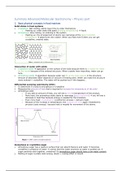Samenvatting
Summary Advanced Molecular Gastronomy - Physics part
- Instelling
- Wageningen University (WUR)
Summary of the course Advanced Molecular Gastronomy (Master Food Technology, WUR). This summary is about the Physics part (lectures, knowledge clips, reader): The subjects are: - Basic physical concepts in food matrices - Ice cream - Chocolate - Water diffusion in bread - Bakery products - D...
[Meer zien]




